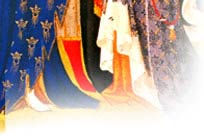 |
|||
 

|
Medieval History of France France derives its name from a medieval tribe called the Franks. In 481, a 15-year old named Clovis (a form of "Louis," which would become the favorite name of French royal dynasties) became leader of his small Frankish tribe. He soon began killing off the other family members of his family to reduce the number of people competing with him for authority. Afterwards, he consolidated other tribes and within five years, he had united the Franks under his personal rule. The Franks were not sophisticated or highly organized, like the Ostrogoths or Visigoths they were hunters, trappers and supplied recruits for Roman armies. Clovis died in 511, and the Frankish kingdom was divided among his four sons. Royal descendants of Clovis became known as the Merovingian dynasty, named after Clovis' grandfather, Merovech. Viking invaders of the early Middle Ages left their influences on France as well, especially in their manner of warfare. William the Conqueror used these tactics to his advantage when, in 1066 he invaded England. The Bayeux Tapestry, a masterpiece of medieval art, serves as a record of the events and tactics used during this invasion. Norman castles that dotted the French landscape would soon be incorporated across the British Isles. Power shifted back and forth between these two countries. In 1152, much of France was under the control of the English when Eleanor of Aquitaine married Henry of Anjou. One of the most important rulers of medieval history was Charlemagne whose empire, known as the Carolingian dynasty, included the greater section of central Europe, and northern and central Italy. His system of government divided the realm into regions ruled by local "counts." Faith played an important role in France's development druing the Middle Ages. Pope Urban II in preached the First Crusade in Clermont, France in 1095, and this country played a leading role in subsequent crusades. Major cathedrals were erected across France between the 12th and 14th centuries. The famous Notre-Dame de Paris was begun in the 1100s. France's medieval heroines include Jeanne D'Arc (Joan of Arc), who, in 1429, followed direction she received in visions to expel the English and install Charles VII as the rightful king. She was victorious in the Battle of Orleans, but failed to capture Paris, and in 1430 she was captured by Burgundians and sold to the English. Two years later she was burned at the stake in Rouen. |
 |
|
 |
|||
 |
|||